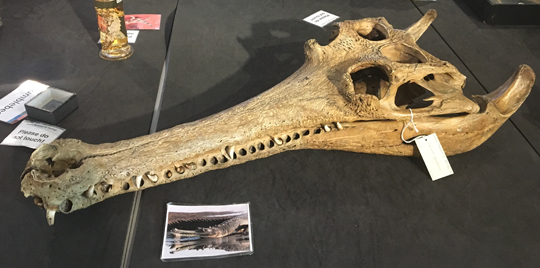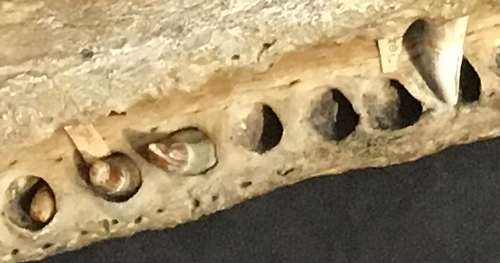A Feature of the Archosauria – (Part 1)
Examining Teeth in Sockets – Crocodilians (Archosauria)
Team members at Everything Dinosaur were given the opportunity to examine the skull of a large gharial recently. The gharial (Gavialis gangeticus), has evolved a long, elongated snout and specialises in catching fish (piscivore). These once widespread and diverse members of the Gavialidae are extremely rare in the wild. They are restricted to a few fragmentary populations scattered amongst the river systems of the northern parts of the Indian sub-continent. It is a member of the Archosauria clade.
Examining the Skull of a Large Gharial

Picture credit: Everything Dinosaur
Crocodilians are Members of the Archosauria Clade
The skull of this crocodilian portrays several characteristics that identifies it as a member of the Archosauria, the same clade of reptiles that includes dinosaurs, pterosaurs and birds. The skull has a number of holes in it (fenestrae), these holes establish it as a member of the diapsid, one of three main groups of reptiles that can be distinguished from each other by the presence or absence of such fenestrae and their number.
Establishing shared characteristics between different species (synapomorphies), is the standard model for classifying organisms. These shared characteristics, came from a shared, common ancestor. Essentially, taxonomists are looking to identify similarities and differences. The number of holes in the skull is one of the synapomorphies that establishes this gharial as a member of the archosaurs (ruling reptiles).
Teeth in Sockets
Another synapomorphy shared amongst the Archosauria, (although derived members of this group such as the birds have subsequently lost this trait), can be seen in the jaw. The teeth of the gharial are set in sockets. These sockets are termed alveoli (singular alveolus). Being strongly anchored in a bony socket allows the tooth to withstand greater forces. It is less likely to be lost during predation and feeding. This enabled many of the early archosaurs to evolve powerful jaws, capable to tacking struggling prey or coping with tough, fibrous vegetation. This evolutionary trait may help to explain their success.
For models and replicas of archosaurs and other prehistoric animals: Dinosaurs and Other Prehistoric Animal Models.
On the Skull of the Gharial – the Teeth Sockets can be Easily Seen

Picture credit: Everything Dinosaur
Visit the Everything Dinosaur website: Everything Dinosaur.

